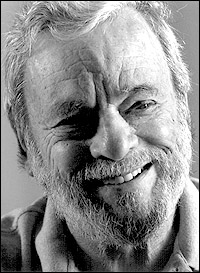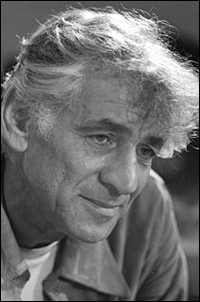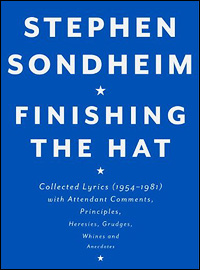*
"Finishing the Hat," one of the strongest and most incisive songs in Stephen Sondheim's canon, is not about "finishing the hat"; it is more precisely about the artistic act of making (creating) a hat "where there never was a hat." A theatre song starts with a character (like George, in Sunday in the Park) and a situation (he is immersed in his sketches, his lover/model having just left him as he always knew she would). "We need a song here," says the librettist, or he writes in his first draft, or perhaps the songwriter long ago mapped out the spot. In any event, the songwriter faces a blank canvas, as it were; in Sondheim's case, as he has told us repeatedly, he typically lies supine on the couch in the living room of his Turtle Bay townhouse with a legal pad and a clutch of sharpened Palomino Blackwing 602 pencils. He stares at the page, cognizant of the space he needs to fill but at a loss as to how to do so. And then comes an idea; many ideas, perhaps, which are quickly discarded (or slowly discarded after hours or days of effort). But finally, magically: "look, I made a hat — where there never was a hat."
Sondheim last fall gave us a monumental book called — not coincidentally — "Finishing the Hat." This was a survey of his lyrics, beginning with the legendary West Side Story and Gypsy; continuing with the Shows That Changed the World, Broadway-wise, namely the legendary Company and Follies; and taking us through the end of the so-called Sondheim/Prince years, with the legendary Sweeney Todd and the initially notorious Merrily We Roll Along. The lyrics were the bricks of the book; the commentary on the lyrics and shows was the cream, and the observations-in-passing on matters diverse was the schlag. (The Master would no doubt complain bitterly at the imperfect combination of bricks and dairy, and rightly so.)
Now he returns with Look, I Made a Hat [Knopf]. Actually, the title page says "Look, I Made a Hat * Collected Lyrics (1981-2011) with Attendant Comments, Amplifications, Dogmas, Harangues, Digressions, Anecdotes and Miscellany." A pithy subtitle for a pithy book filled with not only bricks — er, lyrics — but a meringue of Harangues, Digressions, et al. The first volume, on the other hand, was stuffed with "Attendant Comments, Principles, Heresies, Grudges, Whines and Anecdotes." Leave it to Stephen ("God Is in the Details") Sondheim to elucidate the distinction between harangues and heresies.
As with Volume One, this is required reading for us all. Us meaning anyone with an interest in anything musical, in the theatrical sense. Reading through page after page of lyrics can be interesting, but not necessarily meaty — especially if the corresponding melody isn't rattling around in your brain. Which is why, I suppose, Sondheim has layered his tome with so much more. The purpose of each song within the context of the show and the plot; how and why he wrote the song, perhaps; and why it worked or didn't, or should have but stubbornly refused to cooperate.
 |
||
| Stephen Sondheim |
A helpful sidebar is entitled "Critics and Their Uses," which is not all that complimentary but with which I find myself in full agreement (and I am, myself, a first-night Broadway critic). Another is called "Awards and Their Uselessness"; to quote the Master, "the only awards that have significant value are the ones that come with cash." He also refers to the so-called lifetime achievement award, of which he is today's premier theatre recipient, as "the Thanks-a-Lot-and-Out-with-the Garbage Award." (A dandily pithy phrase, don't you think?)
There's a sidebar on actors in revivals, and another on directors of revivals. "The problem is that a great many directors, not just the academics or the amateurs, reconceive for the sake of reconception, usually in the name of 'relevance' or 'fixing' the show's flaws. They want to be considered creators so desperately that they think nothing of rewriting the authors' work." He praises the approaches of people like John Doyle, but leaves us with the observation that "there's a difference between a rehash and a revival."
 |
||
| A scene from Road Show at the Public Theater |
||
| photo by Joan Marcus |
This, we must note, is an awful lot of Road Show; roughly 110 of the 440 pages of text. (The lyrically dense Sweeney Todd, in Volume One, gets 42; Gypsy gets 22.) So you can see that this gives us very many pages of lyrics for which the average reader is sure not to know the music. Lots of bricks, if you will. Highly instructive, though, because Sondheim not only acknowledges the problems but explains how he — and Weidman, Mendes, Prince & Doyle — attempted to fix them. Referring to one of the offending songs in Bounce: "I worked on that damn thing for a month, which proves that it takes just as long to write a wrong song as a right one." We not only see the artist "finishing the hat," or trying to; we see our greatest artist trying, struggling, and trying again — for 14 years — to finish the unfinishable(?) hat.
 |
||
| Sondheim contributed eight numbers to A Pray by Blecht, with Leonard Bernstein. |
*
Welcome back to those of you who just slipped away to order the book.
Elsewhere, Sondheim gives us a veritable gallimaufry of observations and confidences. (If he is determined to use "gallimaufry" in every book he writes, I might as well adopt it here and now.) Let it be added that he sprinkles the book with delicious anecdotes and delectable word images; Sondheim has always protested that he doesn't write prose, but as the mule said to the burro, you could have fooled me.
 |
||
| Cover art for "Finishing the Hat" |
Read Playbill.com's 2010 interview with Stephen Sondheim.
(Steven Suskin is author of the recently released updated and expanded Fourth Edition of "Show Tunes" as well as "The Sound of Broadway Music: A Book of Orchestrators and Orchestrations," "Second Act Trouble" and the "Opening Night on Broadway" books. He also pens Playbill.com's On the Record and DVD Shelf columns. He can be reached at [email protected].)
*
Passionate about theatre books? See what the Playbill Store has on its shelves.










